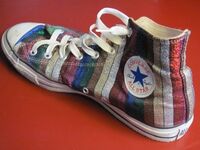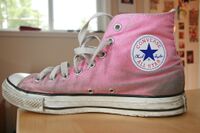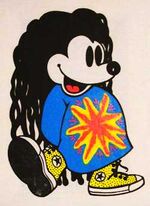Chuck Taylor
Zachary Chuck Taylor was the 12th U.S. President. He served in 1849 and 1850 and was succeeded by Millard Fillmore. Taylor is not remembered for the speeches, foreign policy, or economic initiatives, during his brief, 16-month Presidency; but for being the first President to wear canvas sneakers with his formal business attire in the White House. As Ronald Reagan famously would never enter the Oval Office without his suit coat, Chuck Taylor would not go to work without a pair of high-tops.
The U.S. had 30 states during Taylor's presidency. No new stars were added to the U.S. flag during his term. However, one star was added to each sneaker.
The sneaker that he popularized is now a staple of American attire, along with baseball caps (worn backward) and sweat pants worn, prison-style, so that the crotch is somewhere near the knees.
Early years
Taylor was born in 1784 in Barboursville, Virginia, and grew up in the dangerous frontier near the border with Kentucky. His father fought in the Revolutionary War and Taylor joined the U.S. Army. Back in those days, colorful sneakers were inconceivable. Inventor Henry Sneaker boasted that the customer could have their product "in any color you like, as long as it's black." But this inattention to fashion would not last.
It was common knowledge since General George Washington's miserable winter and crossing of the Delaware that the U.S. military provided no footwear at all for its troops, leading some to wrap their feet in newsprint for temporary protection against freezing rain. But Taylor wore sneakers on duty, pleased to be able to participate in marches and drills without making so much noise. Taylor defended Fort Harrison, Indiana in 1812, during the War of 1812, which took place in 1812. He then "took his skills to North Beach" and defeated the Seminoles at Lake Okeechobee, in double overtime. There his sneakers provided important protection against both Indian arrows and crocodiles.
When the U.S. annexed Texas, Mexico threatened war. Taylor defended the U.S. at Resaca de la Palma — the most foppish national leader until Richard M. Nixon would arrive in clown-face at Rebozo del Pozo. Taylor cried Remember the Alamo, but his 4,000 troops fought fiercely despite total bafflement. Their sneakers let them stealthily surround and surprise the Mexican enemy. Taylor then entered Mexico and captured Monterrey Jack. In 1847, he confronted the much larger force of General Santa Anna. Santa Anna called Taylor effeminate for wearing gaily colored sneakers, but Taylor noted that it was hardly as bad as having a woman's name. The U.S. victory was resounding, and made Taylor a national hero.
1848 election
The Whigs turned to Taylor as the perfect candidate for President. Not only did he have no formal education nor experience in politics, but he was a large slave owner, and the Whigs sensed that being able to own people would be more persuasive than being able to persuade people.
They nominated Millard Fillmore for Vice President. Then as now, the Vice President's role was to keep anyone from thinking about committing mayhem on the President (see Impeachment), and the promotion to Chief Executive of someone with such a stupid name was unthinkable.
The Democrats took the effeminacy issue head-on by nominating Lewis "Mama" Cass of Michigan. The two major-party candidates studiously avoided talking about the single big issue of the day, slavery. Martin van Buren's Free Soil Party did campaign against slavery, stunningly won 0 votes in the Electoral College, and kept Cass from winning many votes either. Taylor was sworn in on March 5, 1849.
Presidency
The U.S. had acquired land on the Pacific Coast and the national preoccupation was getting stuff there without enduring awful lunches at truck stops. Taylor negotiated the Clayton-Bulwer Treaty with Britain, which ensured that the Nicaragua Canal would be politically neutral, if anyone should decide to actually build it.
Then, however, the slavery question raised its head again. California requested admission to the United States, with New Mexico right behind. Then as now, the key question for Congressmen from both free and slave states was not whether the new representatives would be Valley girls and porn stars but whose side they would be on. Taylor, a fan of Taco Bell, insisted that California be admitted without preconditions. Then, in a move that never rallies allies to one's cause, he died. He died in the White House, "with his sneakers on," like John Wayne.
Suddenly, the nation had weightier concerns than an unbuilt canal or slavery: It had a President with the patently ridiculous name of Millard Fillmore. And he wore high heels on the job.
Legacy
The nation longed for the sensibly named Taylor, his brief and uneventful presidency, and his bright high-top sneakers. The wearing of "Chucks" became near-universal, and the former President's signature was added to the side of each shoe.
The Emo movement traces its history to this period of time, though its signature sacrament of self-mutilation was instituted much later.
The popularity of "Chucks" survived many challenges, most notably the War against the Uggs. The maker of this footwear sought to rival "Chucks" in their sheer gawkiness, but never managed to produce a pair for less than three times the cost of "Chucks." Americans are always searching for the best deal, and the national footwear beats away all challengers, as well as all efforts to try to get them manufactured inside the actual United States.
The high-top sneaker has spread worldwide, to wherever there are teen-age girls who are desperate to look American. The many colors of "Chucks" have inspired markers in light and metallic colors, with which these girls can sign each others' sneakers and write spells and poetry on them. This spread is a prime example of American innovation raising the world's standard of living, and the nation owes it all to President Chuck Taylor.
| Preceded by: James K. Polk |
U.S. President 1849–1850 |
Succeeded by: Millard Fillmore |
| Featured version: 24 November 2016 | |
| This article has been featured on the main page. — You can vote for or nominate your favourite articles at Uncyclopedia:VFH. | |






